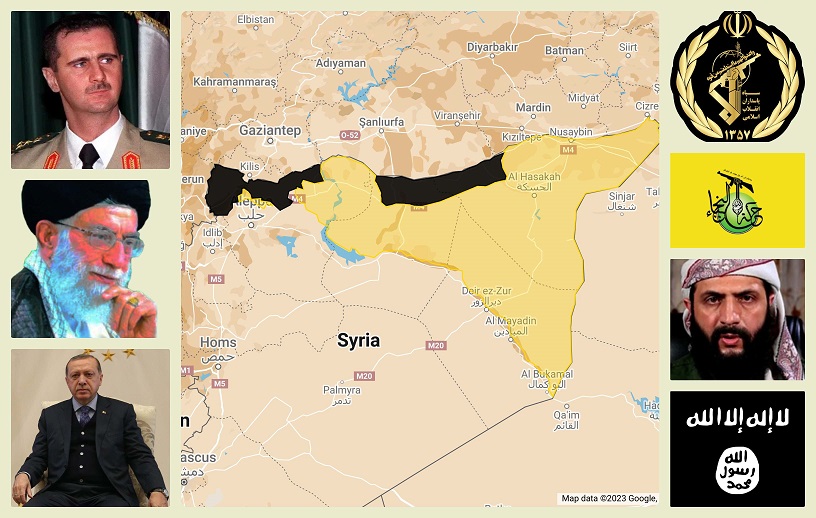An examination of the situation in Syria highlights the imperative for the ongoing US mission. The looming possibility of an ISIS resurgence and the proliferation of diverse terrorist organizations accentuate the necessity for sustained US engagement. Furthermore, the expanding influence of regional and international powers, including Iran, Turkey, Russia, and China, adds a layer of complexity to the geopolitical landscape.
Note: Conflict data are sourced from the Armed Conflict Location & Event Data Project (ACLED). ACLED data available at www.acleddata.com <http://www.acleddata.com>.
The persistent threat of ISIS (Da’esh) resurgence is a critical concern. Despite significant strides in diminishing their territorial control, the possibility of a resurgence looms. The U.S. mission plays a crucial role in preventing the resurgence of this extremist group and upholding stability in the region through a symbolic presence. Additionally, the mission involves training and supporting local forces to effectively counteract terrorist activities.
- Da’esh Attacks Since March 23, 2019
With U.S. support, the Syrian Democratic Forces (SDF) successfully eradicated Da’esh’s physical “Caliphate” on March 23, 2019, concluding years of relentless military campaigns that reached every city, town, and village occupied by the terrorist organization. Despite the jubilation during the victory celebration, both U.S. and Kurdish officials issued warnings that the triumph did not signify the complete elimination of the group, which had held significant territory in Iraq and Syria for an extended period.
Shortly thereafter, the terrorist organization reverted to its previous tactics, adopting guerrilla warfare and emphasizing quality attacks over quantity. This shift underscored the persistent threat posed by Da’esh, signaling a continuation of security challenges in the region despite the territorial defeat of its physical “Caliphate.”
The chart below indicates that out of the 14 governorates in Syria, 12 have faced attacks by Da’esh. Particularly noteworthy is the sustained vulnerability of former Da’esh “Caliphate” strongholds, including Deir Ez Zor, Ar Raqqa, and the southern part of al Hasakah, which continue to be the most targeted areas in Syria. Notably, Homs has emerged as the second most attacked area after Deir Ez Zor, marking a significant uptick in incidents since 2021, primarily concentrated in the Syrian Desert—a significant hotspot within the Ar Raqqa-Homs-Deir ez-Zor triangle.
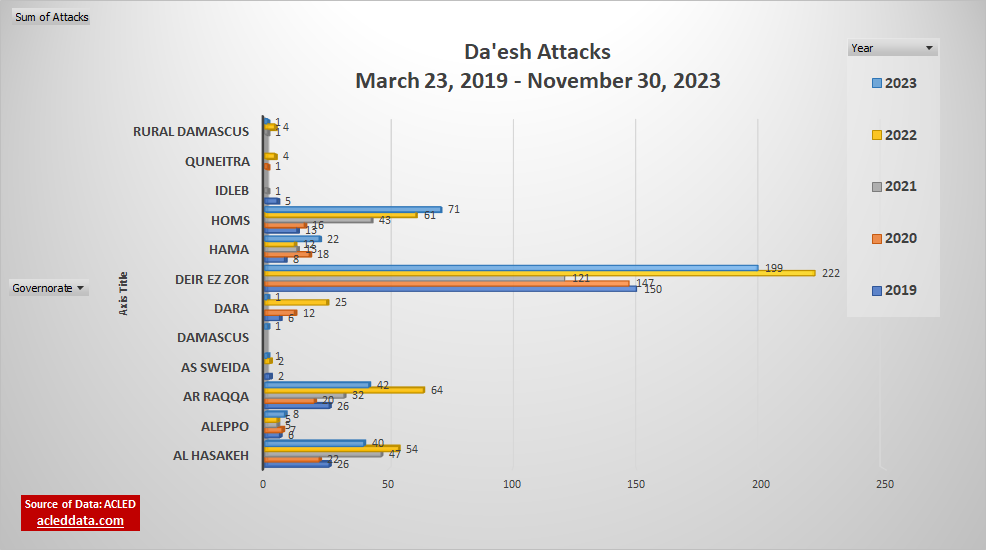
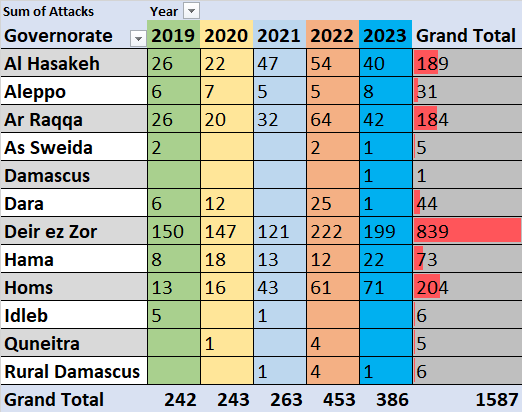
Interactive map of Da'esh Attack in Syria
- Attacks in the North and East of Syria
The Autonomous Administration for North and East of Syria (AANES) continues its ongoing anti-Da’esh campaign, receiving support from the US-led global coalition. Within the southern expanse of the AANES, one finds the former “Capital of the Caliphate,” Ar Raqqa, and the entrenched stronghold of the terrorist organization in Deir Ez Zor and South of Al Hasakeh.
Interactive map of Da'esh Attack in the AANES Area
Deir Ez Zor remains a critical hotspot for Da’esh activities, exhibiting a noticeable surge since 2021. While the presented data pertains specifically to areas under the control of the AANES, it’s noteworthy that Da’esh attacks have also targeted towns and villages along the river in Deir Ez Zor, which are currently governed by the Assad regime.
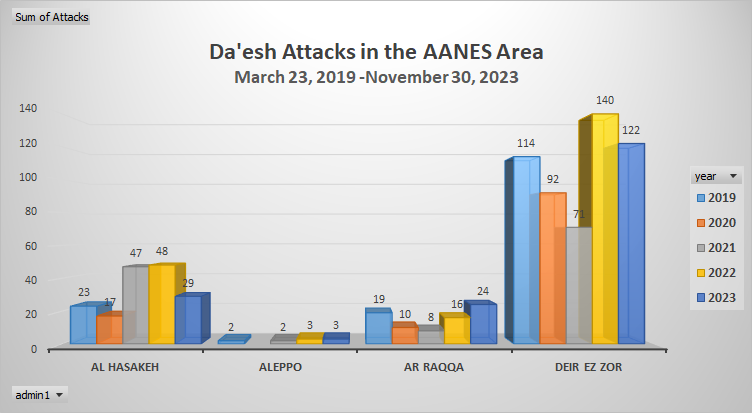
Particularly, the majority of Da’esh attacks have been concentrated in the Basira subdistrict and its surrounding villages. Additionally, Thiban subdistrict has witnessed a significant number of violent incidents, followed by Sur, Kisreh, Susat, and Hajin. Since March 23, 2019, the total number of attacks in eastern Deir Ez Zor has reached 514, representing 32.3% of the total 1587 attacks in Syria. A significant portion, 61.26%, of these attacks occurred in the eastern part under the control of the AANES, while the remaining incidents transpired in the western part governed by the Syrian regime. It is important to note that eastern Deir Ez Zor, within the AANES’s jurisdiction, is intricately linked to Iraq and the Sunni provinces, notably al Anbar, historically associated with al Qaeda since 2003 and Da’esh since 2014.
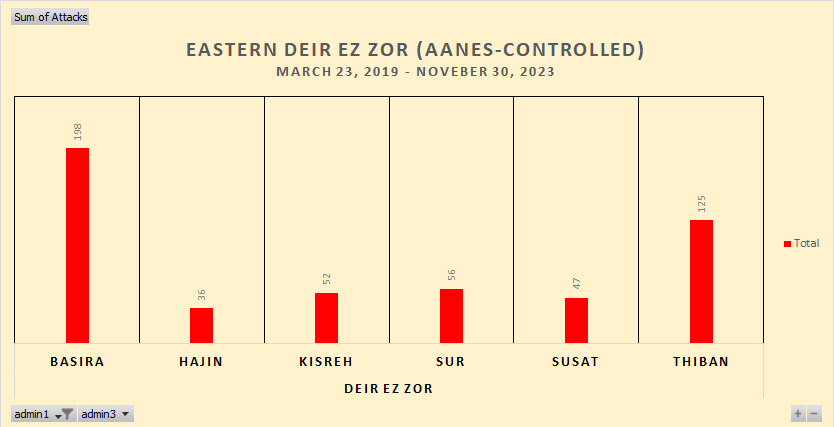
Interactive map of Da'esh Attack in Iraq and Syria
- Da’esh’s Enduring Threat Revealed in the Sana Prison Break
After the Syrian Democratic Forces (SDF) defeated the Islamic State’s ‘caliphate,’ thousands of surrendered and captured ISIS militants came under SDF custody. At present, the SDF detains thousands of ISIS-affiliated prisoners, comprising 25,000 Syrians, 10,000 foreigners, and 5,000 Iraqis. Additionally, various other ISIS-affiliated detainees are located in camps across Rojava and northeastern Syria, with the notorious al-Hol camp in Hasaka holding nearly 70,000 people.
The significant number of prisoners, many still loyal to Da’esh, poses a severe security challenge for the Autonomous Administration in North and East Syria (AANES). This challenge is exacerbated by external pressures, such as Turkish aggression and subversion by Damascus and Tehran. The instability created by a potentially weakened AANES opens the door for a resurgent Islamic State.
The Islamic State has prioritized freeing their captured veteran fighters and supporters from SDF custody. This objective resulted in two major prison breaks, with the most significant one occurring in late January 2022, known as the ‘Battle of Hasakah.’ During this event, Da;esh launched a coordinated attack, including suicide and car bombs, against the main prison. They stormed the facility with a wave of militants while simultaneously carrying out attacks in other neighborhoods of the city.
The attack caused chaos, leading to the deaths of over a hundred SDF personnel and the liberation of somewhere between less than fifty to hundreds of Da’esh-affiliated prisoners, including several leading terrorists. Despite this, the attack was ultimately a failure forDa’esh, as it did not free the thousands of prisoners they had hoped for and resulted in the deaths of nearly 400 attackers and prisoners when the SDF mounted a proper response.
This attack served as a grim reminder that Da’esh was far from finished, emphasizing the need for increased international cooperation with the SDF to prevent the resurgence of ISIS in the region.
Beyond Da’esh, the region has witnessed the growth of various other terrorist organizations. These groups pose a serious challenge to regional security. The US mission serves as a deterrent against the proliferation of these entities, preventing them from gaining a foothold and destabilizing the area further.
- Hay’at Tahrir al-Sham
Hay’at Tahrir al-Sham (HTS) is a prominent Islamist Syrian rebel group that has significantly influenced the course of the Syrian Civil War in northern Syria. Formed in 2017 through the merger of various militia factions, HTS operates under the banner of “popular jihad” against the Assad regime. It traces its roots back to the al-Qaeda affiliate Jabhat al-Nusra.
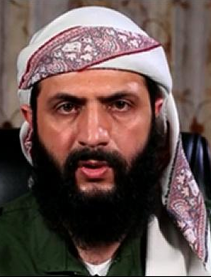
Abu Mohammad al-Julani, HTS’s leader.
While HTS opposes Da’esh, it shares a similar radical ideology aimed at establishing an Islamic State through terrorism, aligning with the strategy of al-Qaeda. HTS has actively sought to expand its territory, challenging the Autonomous Administration for North and East of Syria (AANES), the Assad regime, and other rebel groups. It has become the primary opposition force against the Assad regime, establishing its power base in Idlib province, where ongoing conflicts with the regime persist.
Governing since 2017, HTS has expanded its influence to areas in Aleppo, Hama, and Latakia. It employs an Islamic form of administration, providing essential services in line with its extreme Salafi-oriented ideology and enforcing control through violence. Local funding sources include taxation, extortion, and control of border crossings, with additional income generated through smuggling, trade, and taxation of local businesses. HTS also receives substantial donations from foreign entities.
Despite maintaining a collaborative relationship with Turkey, HTS frequently clashes with Ankara’s proxies, the Syrian National Army (SNA), in Afrin. The group’s governance experience in Idlib, coupled with the divisions among other opposition groups, presents a significant opportunity for HTS to expand further in Syria. Notably, at least two Da’esh leaders were killed by US strikes in Idlib, which serves as the stronghold of HTS.
- Ruling in the Turkish Occupied Territories

As of 2023, Turkey and its Syrian Arab proxy militias control nearly 9,000 square kilometers in northern Syria, after years of military offensives and invasions across their shared border. Turkey’s 2018 Operation Olive Branch brought Afrin Canton, a historically integral part of the Kurdish Region, firmly under the occupation of Ankara-backed Syrian rebels. The 2019 Operation Peace Spring was prompted by former President Trump’s announcement of America’s withdrawal from northern Syria. Though the withdrawal was reversed, the Turkish incursion brought the cities of Tal Aybad, Sari Kani (Ras al-Ayn), and swathes of northern Aleppo, Hasakah, and Raqqa governorates under Ankara’s control.
Turkish-backed armed groups have engaged in a reign of terror and repression against the area’s Kurdish population. Syrian Opposition factions have engaged in a myriad of violent activities across northern Syria. Human trafficking, violent extortion of businesses, attacks on civilian water access, a widespread program of kidnapping for ransom, executions and assassinations, and drug smuggling have all become endemic in Turkish-occupied territory since their seizure from the Autonomous Administration in North and East Syria (AANES). Most damaging has been the deliberate efforts at demographic change by Ankara, with hundreds of thousands of Syrian refugees illegally deported from Turkey and settled into northern Syria. This ethnic cleansing has already turned the former Kurdish-majority of Afrin into a minority, and Erdogan has promised to resettle millions more Syrian deportees across northern Syria as well.
A unique aspect of the occupation is that the armed Syrian opposition groups spearheading the occupation are constantly in a state of hostility and infighting with one another. Over the past several years, units have engaged in deadly clashes and firefights in power struggles, personal vendettas between rebel commanders, and disputes over sources of revenue. Sources of revenue include stewardship over border crossings, which provide important streams of cash for armed groups in the form of tolls and bribes. A recent prominent example of infighting between rival Turkish-backed militias was clashes over shares of revenue from exploiting Kurdish farmers’ yearly olive harvest in Afrin. Until 2022, infighting between Syrian opposition groups, especially in Afrin, was the responsibility of the Syrian National Army (SNA) and Hayat Tahrir al-Sham (HTS). The SNA is the main coalition of Turkish-backed Syrian opposition militias in Syria, and HTS is the powerful Islamist group that controls the majority of Syria’s highly-populated Idlib governorate. The SNA, as an umbrella organization of disparate militias tracing back to the now-largely defunct Free Syrian Army (FSA), has been characterized as being composed of jihadists and mercenaries, as well as more moderate anti-Assad fighters. Though the idea behind the SNA’s founding was to create a more unified framework for anti-Assad forces, there is little cohesion among the SNA’s armed constituent groups. HTS is an outwardly Islamist organization that arose from the unification of Islamist groups and the Al-Qaeda affiliate Al Nusra. HTS is considered a terrorist organization by the United States. HTS has attempted to distance itself from its Al-Qaeda origins, and has expended significant effort in creating a functional Islamic-infused civilian administration for those living in its territory.
Tensions between the two groups came to a head in late 2022 when HTS seized Afrin city from the SNA in a wave of clashes. HTS withdrew from Afrin, but infighting between SNA units has continued to sow instability and chaos across Turkish-controlled northern Syria as of late 2023. SNA units associated with infighting are the Sultan Murad faction, the Hamza Division, al-Jabha al-Shamiya (Levant Front), and the Third Legion, among others. Civilians are often caught between warring factions’ violence, and civilian collateral damage is common in clashes between SNA groups. Life under the Turkish-backed occupation varies from life in the AANES, not only in terms of the prevalence of human rights abuses and oppression, but by the fact that the occupiers are completely unable to enforce stability or order due to their constant and violent rivalries and feuds.
- How Turkish attacks destabilize the region and contribute to the resurgence of Da’esh

Despite agreements with the US and Russia, Turkey persisted in hostilities against the Kurdish-led Autonomous Administration of North and East Syria (AANES) under various pretexts. A systematic harm to civilians is evident, with 114 deaths and 348 injuries reported from January 2020 to July 2023. Furthermore, Turkish forces launched two aggressive bombardments in September and December, resulting in additional civilian casualties and damage to infrastructure.
Compounding the situation, Turkey inadvertently strengthens adversaries of the United States, including the Assad regime, Iranian militias, and Russia. This support bolsters efforts to control AANES and reinstate Assad’s authoritarian rule.
Furthermore, Da’esh terrorists often took advantage of Turkish airstrikes, which paved the way to distract the SDF from guarding the prisons that hold thousands of terrorists. For example, in 2019, hundreds of terrorists fled prisons when Turkey killed Kurdish guards of a prison near Ain Essa.
Turkey’s actions contribute significantly to regional destabilization, hindering the fight against ISIS by targeting effective US-backed forces. The focus on northern and eastern Syria worsens displacement and migration crises, especially among Kurdish communities, perpetuating upheaval and disrupting countless innocent lives.
Iran’s Machinations: Fanning the Flames of Conflict in Deir Ez-Zor
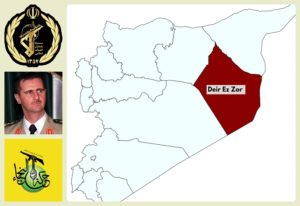
Since late summer of 2023, violence and instability have plagued the Syrian governorate of Deir ez-Zor. The heightened conflict is a result of the Syria-Iran-Russia consensus and their local collaborators attempting to destabilize and overthrow the Autonomous Administration of North and East Syria (AANES). Deir ez-Zor is divided, with the Syrian government controlling the western side of the Euphrates and the AANES the eastern side. This region has become the primary battleground for efforts by Damascus and Tehran to undermine and dismantle the autonomous zone.
On August 27, 2023, the Syrian Democratic Forces (SDF) dismissed and arrested Ahmed Khbeil, also known as Abu Khawla, an Arab SDF commander leading the governance of Deir ez-Zor under the SDF-affiliated Deir ez-Zor Military Council. Abu Khawla faced charges including involvement in drug trafficking, security mismanagement, failure to counter Da’esh activities, recruiting a private militia outside SDF oversight, and cooperating with foreign powers hostile to the AANES. Observers suspected Abu Khawla of being in contact with the Assad regime and pro-Iranian actors, indicating a potential shift in allegiance towards Damascus.
Following Abu Khawla’s arrest, the SDF initiated Operation Security Reinforcement, suppressing remaining Da’esh remnants and countering armed reactions. Arab tribal fighters loyal to Abu Khawla, incited by Assad and Iran, along with militiamen from the Damascus-Tehran camp, staged a violent uprising to free Abu Khawla and weaken the AANES. The SDF’s overwhelming presence quickly quelled the tribal rebellion, but violence initiated by pro-Assad and pro-Iran forces persisted, with Damascus-aligned militias crossing the Euphrates to infiltrate and attack SDF-held Deir ez-Zor.
The ongoing efforts by Assad and Iran to destabilize and overthrow the AANES in Deir ez-Zor have led to a deteriorating security situation, hampering the SDF’s ability to combat Da’esh. The terrorist group has been attempting to regain territorial control over its former “caliphate,” destroyed by the SDF.
Amidst the threats posed by Da’esh, other terrorist organizations, and Turkish aggressions, the Iranian influence, coupled with support for the Assad regime in Deir ez-Zor, presents a significant danger. This collaboration aims to reclaim control over the region, potentially extending to the entire northeast of the country, including AANES areas. Since October 2023, Iranian militias and their Syrian and Iraqi proxies have targeted the US with numerous drone and rocket attacks following the Hamas-Israel war. While using the Hamas-Israel war, Iran’s overarching objective in Syria is apparent: to force the US out and expand their presence within a third of the country currently under the AANES.
Conclusion:
The symbolic presence of the US in Syria has yielded significant gains for national security on multiple fronts. Firstly, through support for local partners, particularly the SDF, the “Caliphate” of Da’esh was effectively thrown away, and currently, the terrorists are unable to occupy areas due to the constant anti-terrorist operation by the US. This achievement was especially crucial amid a lack of cooperation from NATO ally Turkey. Simultaneously, the US has been able to target emerging al-Qaeda affiliates in Syria before they could gain strength.
Secondly, the establishment of the AANES represents a positive step towards regional stability and aligns with US interests, as the region continues to be a key ally.
Thirdly, the US presence has acted as a deterrent to further Iranian influence and militias in Syria. A withdrawal scenario would likely empower Iran and other terrorist organizations, posing a heightened threat to the Middle East.
Fourthly, akin to Iran, the US presence has restricted expansion of Russian influence and deployment in the region. The absence of US influence could complicate NATO dynamics, particularly as Turkey and Russia negotiate new geopolitical maps, potentially undermining the Western alliance.
Fifthly, in light of China’s growing influence, Syrian dictator Bashar al-Assad seeks to open Syria’s doors to Chinese “investment” to alleviate the diplomatic isolation faced by the Syrian regime. The US presence plays a crucial role in navigating and balancing these emerging geopolitical dynamics in the region.

